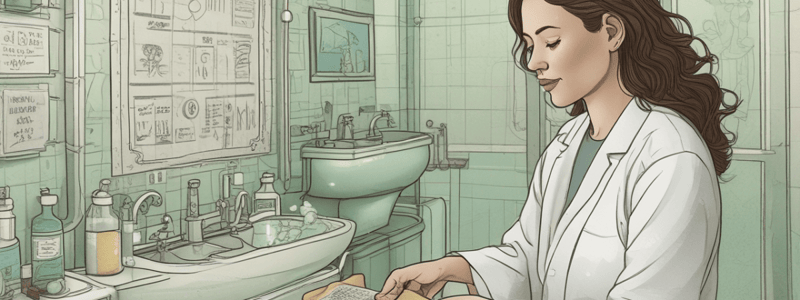Podcast
Questions and Answers
What is one of the basic human needs related to environmental safety?
What is one of the basic human needs related to environmental safety?
- Social interaction
- Financial stability
- Oxygen (correct)
- Leisure activities
Which age group is at risk due to impaired mobility?
Which age group is at risk due to impaired mobility?
- School-age child
- Infant
- Adolescent
- Older adult (correct)
What is a type of accident that can occur in a health care agency?
What is a type of accident that can occur in a health care agency?
- Procedure-related accident (correct)
- Motor vehicle accident
- Natural disaster
- Fire
What is a factor that influences patient safety?
What is a factor that influences patient safety?
What is a common environmental hazard?
What is a common environmental hazard?
What is a way to prevent the transmission of pathogens?
What is a way to prevent the transmission of pathogens?
What is an important aspect of patient safety during the nursing process?
What is an important aspect of patient safety during the nursing process?
What is a developmental stage that is associated with higher risks?
What is a developmental stage that is associated with higher risks?
What is a significant risk in a healthcare environment?
What is a significant risk in a healthcare environment?
What is essential in the planning and outcomes identification stage of the nursing process?
What is essential in the planning and outcomes identification stage of the nursing process?
What type of intervention is used to prevent falls in the home?
What type of intervention is used to prevent falls in the home?
Which of the following is not a type of intervention used in health promotion?
Which of the following is not a type of intervention used in health promotion?
What is evaluated in the evaluation stage of the nursing process through the patient's eyes?
What is evaluated in the evaluation stage of the nursing process through the patient's eyes?
Which of the following is a risk in the patient's home environment?
Which of the following is a risk in the patient's home environment?
What is an example of a nursing diagnosis?
What is an example of a nursing diagnosis?
What is important in the implementation stage of the nursing process?
What is important in the implementation stage of the nursing process?
What is a common denominator among the basic human needs related to environmental safety?
What is a common denominator among the basic human needs related to environmental safety?
How do individual risk factors, such as impaired mobility, impact patient safety?
How do individual risk factors, such as impaired mobility, impact patient safety?
What is the primary focus of the nursing process in relation to patient safety?
What is the primary focus of the nursing process in relation to patient safety?
How do risks in healthcare agencies impact patient safety?
How do risks in healthcare agencies impact patient safety?
What is the primary role of the nursing history and examination in the nursing process?
What is the primary role of the nursing history and examination in the nursing process?
How do economic resources impact patient safety?
How do economic resources impact patient safety?
What is the primary goal of the nursing process in relation to patient safety?
What is the primary goal of the nursing process in relation to patient safety?
How do environmental hazards impact patient safety?
How do environmental hazards impact patient safety?
What is the primary role of the nurse in the nursing process?
What is the primary role of the nurse in the nursing process?
How do disasters impact patient safety?
How do disasters impact patient safety?
What is a critical factor in determining the effectiveness of health promotion strategies?
What is a critical factor in determining the effectiveness of health promotion strategies?
What is a primary goal of the planning and outcomes identification stage of the nursing process?
What is a primary goal of the planning and outcomes identification stage of the nursing process?
What is a key consideration in the implementation of fall prevention strategies?
What is a key consideration in the implementation of fall prevention strategies?
What is a type of disaster that can occur in a healthcare environment?
What is a type of disaster that can occur in a healthcare environment?
What is a critical aspect of the evaluation stage of the nursing process?
What is a critical aspect of the evaluation stage of the nursing process?
What is a nursing diagnosis that may be relevant to a patient at risk for falls?
What is a nursing diagnosis that may be relevant to a patient at risk for falls?
What is a key principle of health promotion in the context of environmental safety?
What is a key principle of health promotion in the context of environmental safety?
What is a critical consideration in the implementation of health promotion strategies in the home environment?
What is a critical consideration in the implementation of health promotion strategies in the home environment?
What is a key aspect of teamwork and collaboration in the context of patient safety?
What is a key aspect of teamwork and collaboration in the context of patient safety?
What is a critical consideration in the analysis and nursing diagnosis stage of the nursing process?
What is a critical consideration in the analysis and nursing diagnosis stage of the nursing process?
Flashcards are hidden until you start studying
Study Notes
Environmental Safety
- Basic human needs include oxygen, nutrition, and temperature.
Common Environmental Hazards
- Motor vehicle accidents, poison, falls, fire, and disasters are common environmental hazards.
Transmission of Pathogens
- Immunizations can prevent the transmission of pathogens.
Factors Influencing Patient Safety
Developmental Stages and Risks
- Infants, toddlers, and preschoolers are at risk due to curiosity and exploratory behavior.
- School-age children are at risk due to increased independence and immaturity.
- Adolescents are at risk due to risk-taking behaviors and peer pressure.
- Adults are at risk due to increased responsibility and decreased supervision.
- Older adults are at risk due to decreased physical abilities and cognitive decline.
Individual Risk Factors
- Workplace culture, lifestyle, impaired mobility, sensory, cognitive, or communication impairment, economic resources, and lack of safety awareness can increase individual risk.
Risks in Health Care Agencies
- Procedure-related accidents, equipment-related accidents, chemical exposure, falls, and workplace safety are risks in health care agencies.
Assessment
- Patient's perspective, nursing history, and examination are essential in assessing patient safety.
- Psychosocial and cultural background, health care environment, and patient's home environment should be considered.
Analysis and Nursing Diagnosis
- Examples of nursing diagnoses include risk for injury, impaired cognition, lack of knowledge, and risk for poisoning.
Planning and Outcomes Identification
- Patient participation is key in planning and outcomes identification.
- Setting priorities based on risk and patient characteristics is essential.
- Teamwork and collaboration are critical, and communication is essential.
Implementation
Health Promotion
- Developmental interventions should be tailored to the patient's age, including infant, toddler, preschooler, school-age child, adolescent, adult, and older adult.
- Environmental interventions, such as fall safety in the home, are essential.
- General preventive measures, such as immunizations, are important.
Acute and Restorative Care
- Fall prevention strategies, such as restraints and side rails, are necessary.
- Preventing workplace violence, fires, electrical hazards, seizures, and disasters are essential components of acute and restorative care.
Evaluation
- Patient's expectations and satisfaction should be evaluated to determine the effectiveness of care.
Environmental Safety
- Basic human needs include oxygen, nutrition, and temperature.
Common Environmental Hazards
- Motor vehicle accidents, poison, falls, fire, and disasters are common environmental hazards.
Transmission of Pathogens
- Immunizations can prevent the transmission of pathogens.
Factors Influencing Patient Safety
Developmental Stages and Risks
- Infants, toddlers, and preschoolers are at risk due to curiosity and exploratory behavior.
- School-age children are at risk due to increased independence and immaturity.
- Adolescents are at risk due to risk-taking behaviors and peer pressure.
- Adults are at risk due to increased responsibility and decreased supervision.
- Older adults are at risk due to decreased physical abilities and cognitive decline.
Individual Risk Factors
- Workplace culture, lifestyle, impaired mobility, sensory, cognitive, or communication impairment, economic resources, and lack of safety awareness can increase individual risk.
Risks in Health Care Agencies
- Procedure-related accidents, equipment-related accidents, chemical exposure, falls, and workplace safety are risks in health care agencies.
Assessment
- Patient's perspective, nursing history, and examination are essential in assessing patient safety.
- Psychosocial and cultural background, health care environment, and patient's home environment should be considered.
Analysis and Nursing Diagnosis
- Examples of nursing diagnoses include risk for injury, impaired cognition, lack of knowledge, and risk for poisoning.
Planning and Outcomes Identification
- Patient participation is key in planning and outcomes identification.
- Setting priorities based on risk and patient characteristics is essential.
- Teamwork and collaboration are critical, and communication is essential.
Implementation
Health Promotion
- Developmental interventions should be tailored to the patient's age, including infant, toddler, preschooler, school-age child, adolescent, adult, and older adult.
- Environmental interventions, such as fall safety in the home, are essential.
- General preventive measures, such as immunizations, are important.
Acute and Restorative Care
- Fall prevention strategies, such as restraints and side rails, are necessary.
- Preventing workplace violence, fires, electrical hazards, seizures, and disasters are essential components of acute and restorative care.
Evaluation
- Patient's expectations and satisfaction should be evaluated to determine the effectiveness of care.
Studying That Suits You
Use AI to generate personalized quizzes and flashcards to suit your learning preferences.





